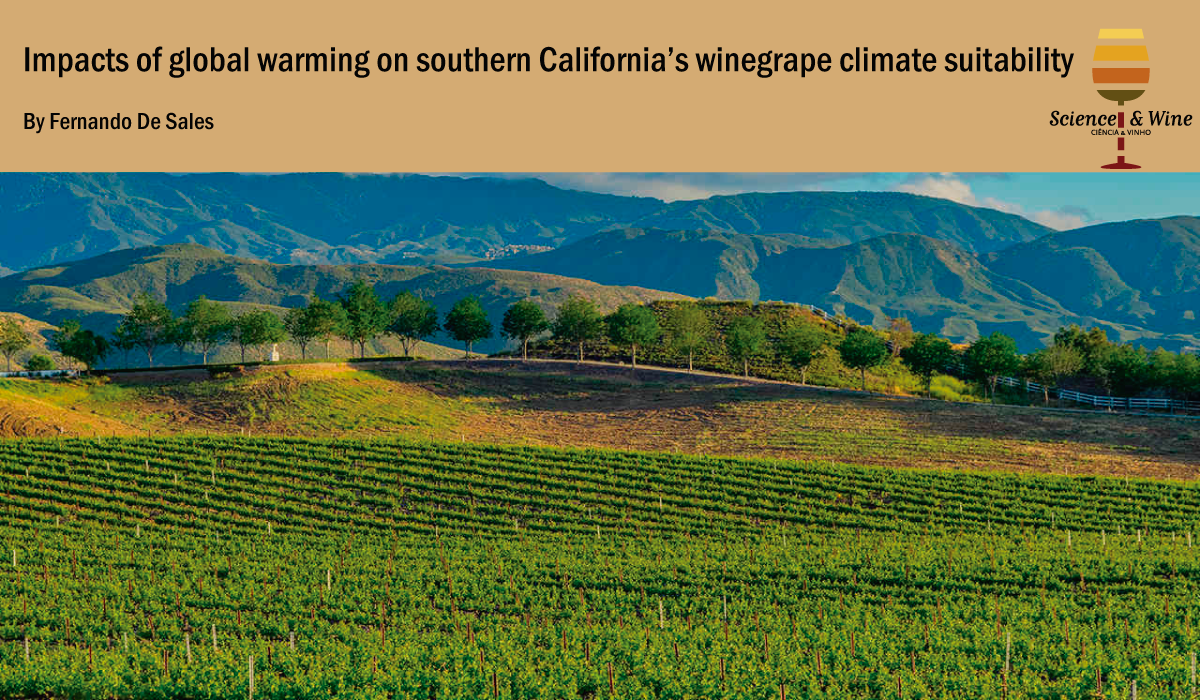By Fernando De Sales
Winegrape is a valuable perennial crop in Southern California. Grapevines were first introduced to the area in the late 18th century and their production has grown economically and gained favorable attention particularly since the 1990’s. Currently, winegrape is grown in four subregions located near the coast and in higher-elevation vineyards, where climate suitable with cooler summer temperatures and more humid conditions (Figure 1).
This according to a report by the San Diego County Vintners Association, an organization that supports the winemaking community in the county, gross sales in 2018 in the region increased 57.1% over 2017 sales. In addition, the total number of jobs in the wine industry increase in 2018 by about 10%. A similar report for Santa Barbara county states that the local wine industry supported 9158 full-time equivalent jobs and had an economic impact of US$1.7 billion statewide.
Despite being an economically viable crop to the region, winegrowing land has limited geographic extent and is very sensitive to climate. Studies indicate that winegrape may be more sensitive to climate change than other regional crops such as walnut, orange, avocado, and corn. Recent trends in regional temperature and precipitation have raised concerns over the impact that long-term climatic change on winegrape suitability in the region.

Unlike its better-known neighbors in Central and Northern California, however; studies on the effects of global warming in Southern California’s viniculture have been limited. Recently, Dr. Fernando De Sales, from San Diego State University, and graduate student Corrie Monteverde carried out a series of high-resolution climate change projections to evaluate potential changes in winegrape climatic suitability under a business-as-usual greenhouse-gas emissions scenario. The study published in August 2020 in the journal Advances in Climate Change Research suggests that global warming will significantly reduce the extent of suitable land for winegrape cultivation in the region by mid-21st century.
The extent of suitable land calculated for different categories based on growing-season temperature index for 2050 suggests a reduction in suitable land for the cultivation of cool, intermediate, warm, and hot climate grape varieties of approximately 19%, 16%, 17%, and 11% respectively (Figure 2). On the other hand, the projections indicate that the extent of areas classified as very hot will increase by nearly 9% on average with most of that increase occurring in the southernmost subregion.
Similar results are also obtained when using other bioclimatic indices such as the heliothermal index, the growing-degree-day index, and the cool night index. In this case of heliothermal index, land suitable for the cultivation of cool to temperate winegrape varieties are projected to shrink by approximately 22% and 15%, respectively, while suitable land for warm and hot classes may reduce by about 5% and 7% on average (Figure 3). In addition to the warmer temperatures, our simulations show a decline in annual rainfall in the region of about 11%. More information on the study’s methodology, bioclimatic indices, and model results can be found in Monteverde and De Sales (2020).

The authors of the study state that the consequences of these climatic changes could have a substantial impact on local winegrape chemistry, including elevated sugars, lower acid concentrations, and decline in wine quality. Furthermore, limited suitable land for crop may reduce wine production and lead to higher prices in the future. These results further underscore the need for adaptive capacity within the sector to maintain the region’s wine identity and profitability.


Fernando De Sales, PhD
Assistant Professor of Climate Science
San Diego State University
Department of Geography
fdesales@sdsu.edu
Research interests:
Land-atmosphere biophysical interactions.
Climate response to land-use and land-cover changes.
Global warming impacts on crop sustainability.
Climate modeling techniques.
References
Monteverde C. and De Sales F. (2020) Impacts of global warming on southern California’s winegrape climate suitability. Advances in Climate Change Research. DOI: 10.1016/j.accre.2020.08.002.

